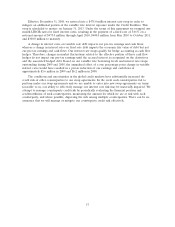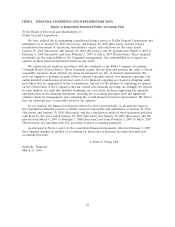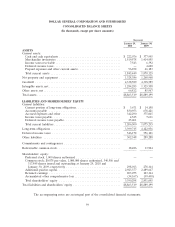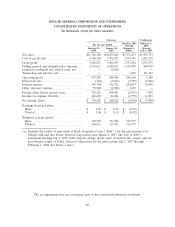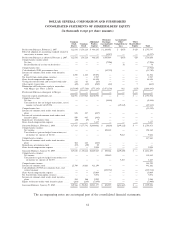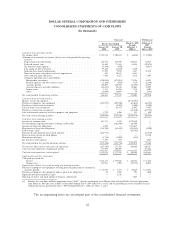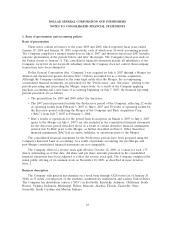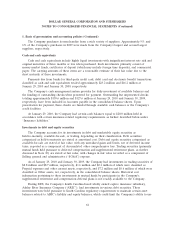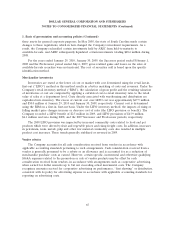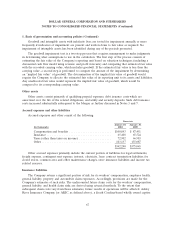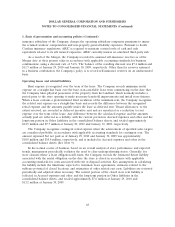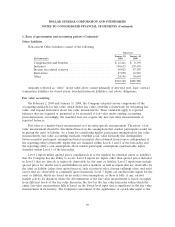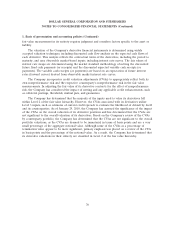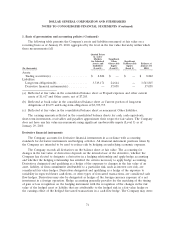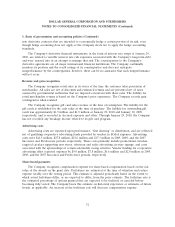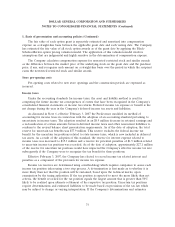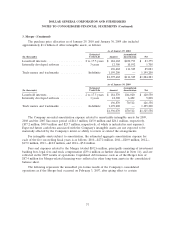Dollar General 2009 Annual Report Download - page 78
Download and view the complete annual report
Please find page 78 of the 2009 Dollar General annual report below. You can navigate through the pages in the report by either clicking on the pages listed below, or by using the keyword search tool below to find specific information within the annual report.
DOLLAR GENERAL CORPORATION AND SUBSIDIARIES
NOTES TO CONSOLIDATED FINANCIAL STATEMENTS (Continued)
1. Basis of presentation and accounting policies (Continued)
Goodwill and intangible assets with indefinite lives are tested for impairment annually or more
frequently if indicators of impairment are present and written down to fair value as required. No
impairment of intangible assets has been identified during any of the periods presented.
The goodwill impairment test is a two-step process that requires management to make judgments
in determining what assumptions to use in the calculation. The first step of the process consists of
estimating the fair value of the Company’s reporting unit based on valuation techniques (including a
discounted cash flow model using revenue and profit forecasts) and comparing that estimated fair value
with the recorded carrying value, which includes goodwill. If the estimated fair value is less than the
carrying value, a second step is performed to compute the amount of the impairment by determining
an ‘‘implied fair value’’ of goodwill. The determination of the implied fair value of goodwill would
require the Company to allocate the estimated fair value of its reporting unit to its assets and liabilities.
Any unallocated fair value would represent the implied fair value of goodwill, which would be
compared to its corresponding carrying value.
Other assets
Other assets consist primarily of qualifying prepaid expenses, debt issuance costs which are
amortized over the life of the related obligations, and utility and security deposits. Such debt issuance
costs increased substantially subsequent to the Merger as further discussed in Notes 3 and 7.
Accrued expenses and other liabilities
Accrued expenses and other consist of the following:
Successor
January 29, January 30,
(In thousands) 2010 2009
Compensation and benefits ......................... $100,843 $ 87,451
Insurance ...................................... 65,408 65,524
Taxes (other than taxes on income) ................... 72,902 66,983
Other ......................................... 103,137 155,087
$342,290 $375,045
Other accrued expenses primarily include the current portion of liabilities for legal settlements,
freight expense, contingent rent expense, interest, electricity, lease contract termination liabilities for
closed stores, common area and other maintenance charges, store insurance liabilities and income tax
related reserves.
Insurance liabilities
The Company retains a significant portion of risk for its workers’ compensation, employee health,
general liability, property and automobile claim exposures. Accordingly, provisions are made for the
Company’s estimates of such risks. The undiscounted future claim costs for the workers’ compensation,
general liability, and health claim risks are derived using actuarial methods. To the extent that
subsequent claim costs vary from those estimates, future results of operations will be affected. Ashley
River Insurance Company (or ARIC, as defined above), a South Carolina-based wholly owned captive
67


